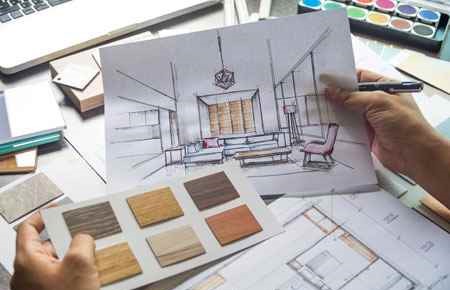
Architecture Majors
Architecture and Related Services
Architecture Careers
To practice architecture means to provide services in connection with the design of buildings and the space within the site surrounding the buildings that have human occupancy or use as their principal purpose. (Wikipedia) People who like precision, are creative and artistic, enjoy aesthetics, and have good math, computer and spatial perception might enjoy a career in an architecture field.
Architecture is hard work. You need to know building and construction, how various materials work, and how to keep aesthetics, safety, cost, scope, and resources all in line to create an end product which satisfies your client. While these can be high-pressure and fast-paced jobs, you have the opportunity to influence a single space or an entire urban area through a career in one of the architecture fields.
What skills are used in architecture careers?
- Knowledge of design skills and principles
- Knowledge of building and construction, including materials and cost structures
- Detail orientation
- Critical thinking
- Interpersonal skills, particularly with client relations
- Communication skills
- Math and science skills
- Analytical and problem solving skills
- Data collection and analysis
- Design and aesthetics
- Stakeholder management
- Collaboration
Some roles to consider in architecture:
- Architect
- Interior designer
- Landscape architect
- Project manager
- Drafter/CAD technician
- Architectural engineer
- Surveyor
- Urban designer
- Conservation architect
- Sustainable design architect
Technology used in architectural fields:
- Augmented reality
- 3D surveying and printing (3ds Max, Enscape (Revit), SketchUp, Rhino)
- Robotics
- Computer Aided Design
- Data Science
- Simulators
- Haptic/kinesthetic communication
- GIS (Graphic Information Systems)
- Biotechnology
- Internet of Things
Here are some different architecturally related careers you might want to consider, if the scope and skills above sound interesting to you.
Sustainable architecture
Sustainable architecture is design which focuses on minimizing the environmental impact of buildings by managing use of materials, increasing efficiencies in the building process and considering the environment at large when creating and placing a building. Knowledge of and use of materials with low emissions, ventilation systems, efficient temperature modulation, and sustainably sourced materials are important in this area of architecture.
Certification in LEED architecture through the US Green Building Council can make you more marketable.
- Principal sustainability architect
- Green building certification manager
- Senior sustainable design specialist
- Sustainability project manager
- Sustainable materials consultant
Landscape architecture
Landscape architects use a knowledge of aesthetics, plants, natural environments, and design techniques to design outdoor areas such as parks, residential areas, campuses, and gardens to achieve environmental, planned use, or visual outcomes. Landscape architects use elements of art, architecture, sociology and engineering to design spaces which are visually appealing, create a specific feeling or mood, and serve a specific purpose.
Landscape architects are required to have a minimum of a bachelor’s degree in Landscape Architecture and all states require licensing, although requirements might vary. Master’s degree programs also exist.
- Landscape architect
- Landscape planner
- Greenway initiator
- Landscape assessor
- Landscape contractor
- Landscape designer
Architectural restoration and historic preservation
If you have an interest in historic buildings, architecture and conservation, architectural restoration and historic preservation might be a career to consider. Architectural restoration specializes in the conservation of historic buildings and other structures; renovation or restoration can help preserve them for the future. Typical requirements ask for a master’s degree in conservation architecture or historic preservation with focus in building renovation and restoration, design and architecture.
- Restoration architect
- Historic preservationist
Urban Planning
Urban planners work to make cities and other living environments healthy, happy, well-designed spaces to live in and focus on the development and design of how land is used and what the environment entails in urban areas. They help create spaces like greenways and parks, revitalize buildings and underutilized areas, create planned communities, and work on infrastructure to accommodate population growth and development.
- Historic buildings inspector/conservation officer
- Housing manager/officer
- Local government officer
- Town planner
- Transport planner
- Urban designer
Interior Design
Interior designers use their skills to create interior spaces which best serve the intended use of the space, focusing on a creating a healthy, visually appealing, and useful experience.
- Visual space planner
- Home stylist
- Residential interior designer
- Design consultant
- Staging assistant
Career Resources
Professional associations are groups of professionals dedicated to topics in specific fields. Professional associations provide a wealth of online resources, some of which are geared specifically towards students. These organizations typically also host conferences and events, providing great opportunities for learning and networking across your field of interest.
- American Design Drafting Association (ADDA)
- American Institute of Architects (AIA)
- American Institute of Architectural Students (AIAS)
- American Society of Architectural Illustrators (ASAI)
- American Society of Landscape Architects (ASLA)
- Association of Architecture Organizations (AAO)
- Association of Collegiate Schools of Architecture (ACSA)
- Association of Licensed Architects (ALA)i
- National Organization of Minority Architects (NOMA)
- Society of American Registered Architects (SARA)
- Society of Architectural Historians (SAH)
- Society of Computer Aided Drafting Designers (SCADD)
Majors and Concentrations
Most careers in architecture require at least a bachelor’s degree—a bachelor of architecture (B.Arch) or master’s degree (M.Arch). Coursework can include:
- Architectural Design, History and Theory
- Environmental Systems
- Building Science and Technology
- Calculus for Architecture
- Visualization
- Math
- Professional Practice
- Planning
- Building Utilities
- Architectural Interior
In other areas of the field of architecture, you can choose to major in:
- Landscape architecture
- Interior design
- Urban or regional planning
- Environmental design
Jobs and Experiences
Most architecture related positions, particularly architects, interior designers, and landscape architects, require a degree and internship/hands-on work experience. After that, you have a wide array of industries and areas to choose from, depending on the type of work you’d like to do.
The most common employers of people in architecturally related fields:
- Architecture firms (Gensler, Perkins and Will, HDR, Jacobs, AECOM, HKS, HOK, Stantec)
- City governments
- Construction companies
- Real estate companies
- Military
- Engineering firms
- Interior design firms (Studio O&A, ICRAVE, Interior Architects (IA), Diva Interior Design)
 Architectural History and Criticism Major
Architectural History and Criticism Major Architectural and Building Sciences/Technology Major
Architectural and Building Sciences/Technology Major Architecture Major
Architecture Major City/Urban, Community and Regional Planning Major
City/Urban, Community and Regional Planning Major Environmental Design/Architecture Major
Environmental Design/Architecture Major Interior Architecture Major
Interior Architecture Major Landscape Architecture Major
Landscape Architecture Major Real Estate Development Major
Real Estate Development Major